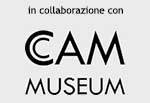
The expanded image
Video art, like any other form of art, is closely linked to contemporary technologies, both for production and for the re-production of works. In the words of Nam June Paik, “whitout electricity can be no art”.
Video art is also the daughter of technology, and its birth is linked to the advent of portable video recording and recording equipment.
This close link between video art and technology has largely also determined the spatial relationship with video art; in common perception, it is linked to the instrument of reproduction — the CRT TV, at its beginning, and then gradually CRT monitors, video projectors, ultra-flat plasma screens …
But in fact — and since its inception — video art has tried to escape the two-dimensionality, and to invade the surrounding space. And there are many artists who, through the practice of video installation, have traveled the road that leads to the conquest of the third dimension; from Vito Acconci to Chris Cunningham, from Bruce Nauman to Tony Oursler, to Nam June Paik, Pipilotti Rist, Bill Viola, Wolf Vostell …
This expansive drive, aimed at taking space, has remained a constant in video art. Differently articulated in time and manner, it has logically found its natural environment in the exhibition space, be it museum or gallery, and even better in public space. In particular, by this impulse born (always in synergy between creative need and technological development) the interactive video installation, and especially videomapping.
The latter, subsequently, has landed a full autonomy, placing itself in a different categorization from video art itself. But its origin is all too evident, both in the conceptual imprinting and — in fact — in the expansive vocation, which in videomapping spreads in dialogue with architecture and in the real appropriation of spatiality, which is expressed in the visual transformation of space same.
Returning to videoart, two examples of expansion in the exhibition space are those of Nam June Paik and Pipilotti Rist, taken here as a representation of the different modes of relationship with the space itself.
Typically, in Paik the escape from the two-dimensionality of the screen finds the keystone in the use of video installation. In its interpretation, this assumes a sculptural characteristic, and the installation becomes in turn a plastic-figurative element. The installation is a recognizable object in itself, and it would also be off-screen. They are often precisely precise sculptural forms, as in the case of anthropomorphic figures built by TV monitors and which seem to hold hands against the wall, or in the wall — still composed of monitors — that draws the territory of the United States, assisted in this colorful neon case to delineate its boundaries.
The fundamental element, constitutive, however, remains the video box, the monitor or the TV, used almost as a brick of a giant Lego.
In a different installation mode, Paik places the video literally in dialogue with the space. The famous installation TV Buddah — differently declined over the years and exhibitions — places a statue of the Buddha in front of a television set, behind which is placed a camera that frames the statue. The latter, therefore, is in meditative contemplation in front of a screen that transmits its own image live.
Here, as mentioned, the video — and the video art installation — enter into dialogue with the space, and interact with it. Not only is the video on direct connection in the exhibition space, but its presentation on the cathode tube records everything that happens in the camera shooting cone (and therefore not only the Buddha, but also everything that happens behind it), and at the same time returns it to the surrounding space. In this, the figure of the Buddha who is standing in front of the television, is not only a symbolic object, but is the iconic representation of this silent dialogue, further emphasized by the anachronistic distance that separates them.
Unlike Paik, Swiss contemporary artist Elisabeth Charlotte Rist, known as Pipilotti Rist, travels a different path for her approach to the expansion of space. The mode chosen by Rist is no longer the installative one, which from a two-dimensional projection expands into space becoming a three-dimensional creature, but — reversing the approach in a certain sense — tends to make itself space. The immersive video projections of the Rist, in fact, are configured in such a way that the video presents itself as the space, in which the visitors move.
In this way, the process of spatial expansion of video art is completed — at least in the state of things — from the use (more or less) frontal in front of a two-dimensional reproduction, then through a mobile use around a structure that includes video, arrives finally at the immersive use, in which the user is within the video artwork.
These, in the exhibition modes of two famous artists, are the main ways through which video art has (so far) expanded into the exhibition space.
Undoubtedly, this trajectory is destined to expand, riding the various opportunities offered by technology. Just think about what can be achieved, when virtual reality will be able to free itself from the constraints of the viewers, or the potential (artistically still unexplored) of augmented reality, only to limit ourselves to the technologies already available today. But also, looking a bit further, to the production of animated holograms.
The long march of video art, from Sony’s Betamovie BMC-100P to the present day, is still far from reaching its conclusion.[
Enrico Tomaselli / 2020-03-01]
<< back




